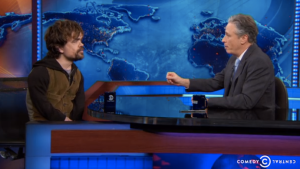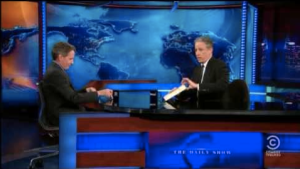The Daily Show: Serving up Politics for the Average Consumer (May 21, 2014)
As I settle down with my cup of tea to watch the Daily Show, I enter into a surreal world where news events of the day are churned back at me once again, resonating with mockery.
The opening credits provide an immediate sense of interconnectedness and familiarity through the circulating globe, and the ever present backdrop of the world map.
I focused in on a clear picture of the show host and renowned comedian, Jon Stewart. He is cheered on by the ever present, yet invisible, audience.
As Jon speaks, I check the time involuntarily, seconds in I am reminded of time due to the urgency of the host in speedily drawing out the content to be aired. Stewart as host is unnervingly present, his tone of voice, facial expressions, body language all play a significant role in the way I personally react to the information.
After the preamble, Stewart launches into a segment where he publicly apologises for offending the Phillies Manager, Ryne Sandsburg. The segment becomes somewhat crude; I think to myself why on earth would ‘this’ be the opening segment. I recall the musings of ‘David Simon’ and his disdain for the average reader, I think to myself F%$# the average viewer too.
Stewart, without skipping a beat launches into the next regular segment called ‘The Democalypse 2014 – The Race to Continued Incumbency.’
He provides an update on the mid-term elections, bringing to life the polls indicating the recent defeat of the Republican Party in many seats. I see the flash of maps on the screen and pin points demonstrating this.
Stewart uses the term ‘purple nurpled’ to describe the state of the Republican Party after the defeat; we all know what that means in the playground, defeat. I notice the usual sender- receiver dynamic is not at play here; Jon himself is speaking with me, not at me. I start to notice the tactics employed to provide the illusion of two-way communication.
Tone, eye contact, facial expressions, open ended questions, inclusive language…I am there, in studio 513 W. Purple Nurpled, that’s funny, I should tweet it. (Tay, Turner, 2010)
I settle back to the show. News, the highest demanded information on television, satisfied I think of the many choices I have available, should I flip the channel? I can download this later, or just check online. No, I keep watching.
The next segment is a full segment called ‘The Election of Doom’ captivated, I was transported to India as the hustle and bustle and colour of India’s markets came into my living room filling my samsung. The idea of bringing democracy to India in an ‘Indiana Jone’s’ fashion was purely entertaining. Hilarious. America exporting politics to 1.2 billion. Ironic. Yes. India, I can almost smell the butter chicken.
The mission to provide democracy quickly turned into a mission to save Indian Television from poor political reporting. My screen transformed into an Indian television, confusing me about the Indian Election, multiple people speaking, dialogue and words I cannot decipher. It placed me completely outside of my cultural comfort zone. Differences between the two cultures of the medium were explored, prettier hosts, graphics, polls etc were praised by India, whilst America playfully mocked India for the confusing way of presenting television news and the corruption of the print news industry.
Final segment, the anticipated interview with Timothy F. Geither. As the guest enters, Jon turns his swivel chair to face him, instantly creating a shift from audience interaction to audience spectatorship.
Stewart physically holds up the item of discussion, recently published, ‘Stress Test, Reflections on Financial Crisis.’ Jon invites the audience to critically evaluate the success or failure of the economic bailout, the interview proceeds in lamen’s terms, analogies of planes crashing, free massages, and so on.
Jon then gives the example of the optical illusion of the young girl or old woman, relative to America’s view of the bailout:
“One might see a young girl, then you flip it, and you see America getting F#$%^&*”.
Ha-ha, the audience echoes with me. Should I tweet that? No, too controversial.
Stewart swivels back, [camera zooms in] direct eye contact, and says:
“I have no idea how we will edit this”.
Snap, I am back on the couch. He continues.
“There is so much about this on the web; ‘we’ might have broken the web”. I laugh.
And close credits. I realise the circulating globe is the world spinning in confusion.
Perplexed I sit up; look at my phone, confused as to how I feel about the last 22 minutes of my life. Jon directly addressed me, offended me, made me cringe, and made me laugh. It was the end of this odd social experience, and I had the desired to share and replicate the information I had obtained (Allen & Hill, 2004). I had engaged in the most essential component of modern democratic society. Yet, I wanted more, phone in hand:
Facebook>Search>The Daily Show with Jon Stewart (Click) make that 4,553,638 likes.



